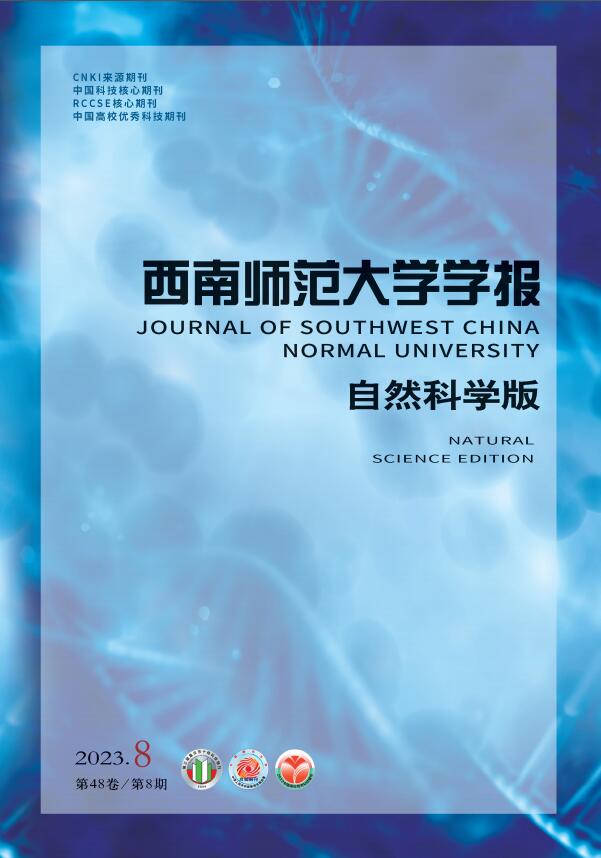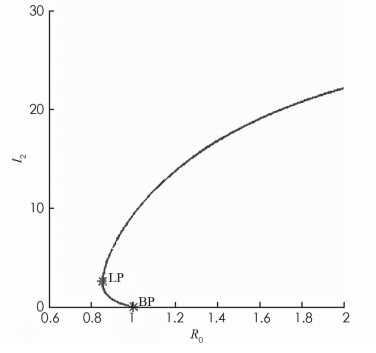-
吸烟是吸烟者罹患肺癌的主要致病因素,而肺癌是全世界癌症死亡的主要原因,每年有100多万人死于肺癌[1].吸烟行为的传播有多种影响因素,尤其是在青少年期间,父母以及身边好友是否吸烟对青少年有着很大的影响.另外,青少年的吸烟行为与烟草行业大量的广告以及社会吸烟风气也有着巨大的关系[2].2015年,根据世界卫生组织报告,全球烟草流行每年导致约600万人死亡,其中60多万人是死于二手烟吸入的非吸烟者,预计到2030年,烟草流行将每年导致800多万人死亡[3].吸烟已经对人类的健康造成很大的负面影响,因此,研究吸烟的传播特点和动态行为是控烟的首要任务.
像许多传染病一样,吸烟的动态过程可以用数学模型来刻画.2000年,文献[4]首次建立了吸烟的数学模型,在这个模型中将总人口分为潜在吸烟者、吸烟者与永久戒烟者;2008年,文献[5]考虑到戒烟不彻底的实际情况,将临时戒烟者纳入到模型中[5];文献[6]扩展了上述模型,将偶尔吸烟者作为一个子种群考虑到模型之中;文献[7-8]考虑了个体接触对个体吸烟者传播的影响;文献[9]考虑了媒介传播与非线性接触率吸烟模型.本文同时考虑个体接触与媒介传播的因素,建立吸烟传播动力学模型研究这两个风险因素耦合作用对吸烟传播行为的影响.
HTML
-
本文基于吸烟者的特点,将种群分为潜在吸烟者、被动吸烟者、主动吸烟者与戒烟者.根据吸烟的传播特点,本文作如下假设和说明:
1) 假设被动吸烟是主动吸烟者与潜在吸烟者通过有效接触形成.
2) 考虑被动吸烟者与主动吸烟者之间的两种传播方式:
其一是被动吸烟者通过与每一个主动吸烟者接触从而变为主动吸烟者;另一种是被动吸烟者通过烟草行业大量的广告以及社会媒介等影响因素转变为主动吸烟者.
3) 考虑戒烟不彻底从而返回到潜在吸烟者.
建立模型如下:
其中:S,I1,I2,R分别表示t时刻潜在吸烟者、被动吸烟者、主动吸烟者以及戒烟者的数量;β表示潜在吸烟者与主动吸烟者的传播接触率系数;μ表示自然死亡率;σ表示由被动吸烟者转化为主动吸烟者的转化率;α表示被动吸烟者与主动吸烟者的传播接触率系数;γ表示戒烟率;δ表示为戒烟不成功又再次成为潜在吸烟者的比率.所有的变量是非负的,参数是正的.
-
系统(1)的可行域为
系统(1)存在无烟平衡点.利用下一代生成矩阵[10],计算出系统(1)的基本再生数为:
设系统(1)存在正(吸烟)平衡点E*=(S*,I1*,I2*,R*),则E*满足
可得
且I2*满足:
其中
通过分析,有以下结论:
定理1 1) 当R0>1时,系统(1)有一个正平衡点.
2) 当R0 < 1时
(ⅰ) 当B < 0时,系统(1)没有正平衡点;
(ⅱ) 当B>0时,若B2=4AC,则有一个正平衡点,若B2>4AC,则有两个正平衡点(如图 1所示).
由定理1可知,当R0 < 1时,系统(1)可能存在正平衡点.这意味着,系统可能会发生后向分支.下面应用文献[11]中的方法,分析系统(1)后向分支的存在性.
考虑R0=1,我们选择β*=β作为分支参数,则有
定义S=x1,I1=x2,I2=x3,R=x4.系统(1)变为:
系统在无烟平衡点的雅可比矩阵为
系统有特征值λ1=0,λ2=-μ,λ3=-(μ+δ),λ4=-(2μ+σ+γ),因此,零特征值相关的右特征向量为w=(w1,w2,w3,w4)T,其中
对应的左特征向量为v=(v1,v2,v3,v4),其中
选取v3使v·w=1,则有
因此,b>0,当
时,a>0.系统出现后向分支(图 1),即有以下结论:
定理2 当
时,系统(1)在R0=1处存在后向分支.
-
定理3 当R0 < 1时,系统(1)的无烟平衡点E0是局部渐近稳定的;当R0>1时,E0不稳定.
证 系统(1)在E0处的Jacobian矩阵为
特征方程为
(6)式有两个负的特征根λ1=-μ,λ2=-μ-δ,其余两个特征根满足下面方程
其中
且a1>0,我们得出:
(ⅰ) 当R0 < 1时,a0>0,则λ3λ4>0,λ3+λ4 < 0,所以λ3,λ4均小于0,所以方程(6)的所有根都具有负实部,因此无烟平衡点E0是局部渐近稳定的.
(ⅱ) 当R0>1时,a0 < 0,则λ3λ4 < 0,所以λ3,λ4的值是一正一负的,因此E0是不稳定的.
定理4 当
时,无烟平衡点E0是全局渐近稳定的.
证 这里容易验证R1>R0.
构造一个Lyapunov函数
其中
$S_{0}=\frac{A}{\mu}$ ,L(t)≥0.计算L(t)沿系统(1)解的全导数,则有
由于
$2-\frac{S}{S_{0}}-\frac{S_{0}}{S} \leqslant 0$ ,故R1≤1时,L′(t)≤0,且L′(t)=0当且仅当$S=\frac{A}{\mu}$ ,I1=0,I2=0,R=0.那么,集合{(S,I1,I2,R):L′(t)=0}的最大不变集为单点集{E0}.根据定理3和Lyapunov-Lasalle原理[12],t→∞时,系统(1)所有的非负解均趋于无烟平衡点E0,所以当R1≤1时,E0是全局渐近稳定的.定理5 对于模型(1),R0>1时,系统是一致持续的,即存在一个正数ε,使得
证 定义
为了证明疾病的一致持续性,在∂X0中,说明模型(1)的解与∂X0的交集是空集.
首先,容易看出X是正不变集,X0是正不变的,且∂X0是X的相对闭集.令P:X→X是系统(1)的Pioncaré映射,即P(x0)=Φ(t,x0),x0∈X,其中Φ(t,x0)是系统(1)满足初值条件Φ(0,x0)=x0的唯一解.记
下面证明M∂={(S,0,0,R):S≥0,R≥0}.即证明对所有t≥0,有I1(t)=0和I2(t)=0.假设该结论不成立,即可分以下两种情况讨论.
第一种情况:存在t0≥0使得I1(t)>0,I2(t)=0,即有
由此可见,存在δ>0,当t0≤t≤t0+δ时
$\frac{\mathrm{d} I_{2}}{\mathrm{~d} t}>0$ .这说明t0≤t≤t0+δ时,(S(t),I1(t),I2(t),R(t))∉M∂,推出矛盾.第二种情况:存在t0≥0使得I1(t)=0,I2(t)>0,即有
由此可见,存在δ>0,当t0≤t≤t0+δ时
$\frac{\mathrm{d} I_{1}}{\mathrm{~d} t}>0$ . 这说明t0≤t≤t0+δ时,(S(t),I1(t),I2(t),R(t))∉M∂,推出矛盾.这就证明了M∂={(S,0,0,R):S≥0,R≥0}.已知E0=
$\left(\frac{A}{\mu}, 0, 0, 0\right)$ 是P在M∂上的一个不动点.如果(S(t),I1(t),I2(t),R(t))是系统(1)在M∂上的一个解,则$\lim\limits_{t \rightarrow \infty} S(t)=\frac{A}{\mu}$ ,$\lim\limits_{t \rightarrow \infty} I_{1}(t)=0$ ,$\lim\limits_{t \rightarrow \infty} I_{2}(t)=0$ ,$\lim\limits_{t \rightarrow \infty} R(t)=0$ .若E0是孤立的,则{E0}是一个非循环覆盖.下面证明E0是孤立的.首先证明Ws(E0)∩X0=φ成立.由解对初值的连续依赖性,∀η>0,∃ε>0,使得有
下证
$\limsup\limits_{m \rightarrow \infty}d\left(P^{m}\left(\boldsymbol{x}_{0}\right), \boldsymbol{E}_{0}\right) \geqslant \varepsilon$ .假设不成立,则∃x0∈X0,使得$\limsup\limits_{m \rightarrow \infty}d$ (Pm(x0),E0) < ε,则||Φ(t,Pm(x0))-Φ(t,E0)|| < η,∀m≥0,∀t∈[0,c],设t=mc+t1,其中t1∈[0,c],m=$\left[\frac{t}{c}\right]$ ,则有令(S(t),I1(t),I2(t),R(t))=Φ(t,x0),t≥0,则
由系统(1)可以得到
考虑一个辅助系统
因为R0>1,由文献[13]中的引理2.1和比较定理可得:
这与0≤I1(t)≤η,0≤I2(t)≤η矛盾,则Ws(E0)∩X0=φ,即M∂中的每一个轨道都收敛于E0,则E0在M∂中是非循环的.由一致持续的非循环定理知,P关于(X0,∂X0)是一致持续的.由文献[14]可知,系统(1)关于(X0,∂X0)是一致持续的.
-
本文基于吸烟传播的特点,考虑个体传播和媒介宣传传播这两个重要风险因素,建立了一个吸烟传播动力学模型.本文首先定义吸烟传播阈值,分析模型的平衡态,发现R0 < 1时,模型可能有两个平衡态,其中一个是局部稳定的,这意味着模型出现后向分支,吸烟可能持续存在;R0>1时,模型有唯一平衡点且模型一致持续,这说明在这种情况下,吸烟一定一直持续存在.最后,本文证明了无烟平衡态的局部渐近稳定性,说明了控烟到低水平的意义.研究结果丰富了吸烟传播动力学,拓展了人们对吸烟传播影响因素的认识,有利于吸烟控制措施的制定.







 DownLoad:
DownLoad: